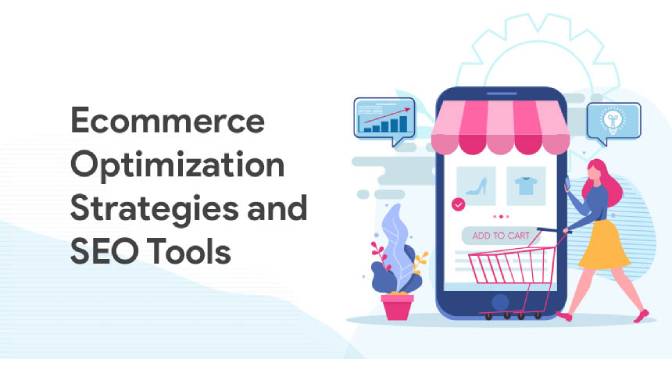2020 SEO Strategy Guide for E-commerce Businesses
Recently updated: October 3rd, 2020
Since Google’s May 2020 Core Update has been announced and rolled out, a lot of e-commerce website owners are working in a frenzy to improve the ranking of their websites. However, being at the top is not the only factor to convert your website’s visitors into customers. Thus, you better focus on a more holistic approach rather than sticking to a few ranking factors – they are just a subpart of the whole conversion process. So, what should you do to become a successful e-commerce business? You need to prepare a Comprehensive E-commerce SEO Strategy.
But before making any plans, you should know why SEO is vital for e-commerce businesses. Once you know ‘why’, devising an effective SEO strategy and making all the efforts to implement it will make more sense to you.
Why is SEO important for E-commerce Websites?
To understand this, let’s take a look at what research, surveys, and studies suggest.
- 91.5% of traffic is generated by the sites that are listed on the first page of Google search – Chitika
- 51% of all website traffic is generated by organic search while only 10% comes from paid search – BrightEdge
- More than 40% of revenue is gathered by organic traffic – BrightEdge
- 4 out of 5 consumers use search engines to find local information – Think With Google
- More than 1 billion people use Google Search every month – Google via Business Insider
- Around 81% of the total search engine share market is attributed to Google – Net Share Market
All these figures reveal a lot about what role the right SEO plays in boosting the revenue and gaining a huge client base and why the ranking of your site on Google’s first page matters. While many companies try to achieve their goals by paid marketing, research shows that only organic traffic is going to bring you more customers in the long-term. Thus, e-commerce businesses should not skimp while investing in SEO.
Now, when you know why SEO is important for your e-commerce website, let’s talk about all the elements that will help you make an effective e-commerce SEO strategy.
- E-commerce Website Architecture
- On-Page SEO for E-commerce Websites
- Technical SEO for E-commerce Websites
- Keyword Research for E-commerce Websites
- Content Marketing for E-commerce Websites
- Link Building for E-commerce Websites
E-commerce Website Architecture
The structure of a website is much more important to an e-commerce business than any other business out there. It’s because when people are shopping, they tend to distract more as they, themselves, are on the fence while making a purchase. Any distraction, such as high loading time, poor design, poor navigation, inefficient categorization or product naming, insufficient product description, low-quality images, improper placement of CTAs, or even product arrangement can affect the decision of a potential customer.
Thus, e-commerce website structure comes at the top priority while doing SEO because if the look and feel of your website is not appealing, your website speed is not good enough, or it is not easy to navigate, even Google would keep it from ranking on the first page.
What to do to improve the architecture of an e-commerce website?
To optimize the architecture of your e-commerce website –
- Keep your website design Clean and Scalable
- Keep every page at most three clicks away from the Home Page.
- Keep the structure of your website flat and simple.
- Concentrate link authority in product and category pages. Not only would your website visitors love it, but Google would also easily find these pages and index them.
Let’s take a real-life example of an e-commerce website “Myntra” that has a well-designed architecture.
Assume you are looking for sports shoes for your little boy on Myntra.
You can easily locate the ‘Kids’ section on the Home Page.

Just bring the cursor on ‘Kids’ and you will see different categories. There, you can easily find the ‘Boys Footwear’ subcategory and then you can easily spot ‘Sports Shoes’.
Click on the ‘Sports Shoes’ category, and you can see the shoes of various brands.
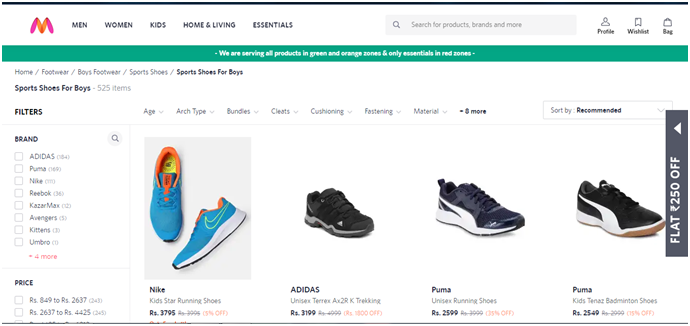
In this case, you are able to find what you are looking for with just 2 clicks after landing on the Home Page.
Since this site uses a simple, scalable, and flat structure, Google won’t have any problem in indexing this site.
On-Page SEO for E-commerce Websites
The architecture of your site is all set. Now, you need to focus on category and product pages because these are the pages that are going to bring you the maximum business i.e., traffic and sales.
To optimize category and product pages, ask three questions to self.
- What is your ‘title tag’?
- What does your ‘description tag’ include?
- Does your product and category page have sufficient content?
Title Tag
Don’t use plain keywords. Make it more informative by adding modifiers, such as cheap, buy, deals, free shipping, online, discount, or off. It will help you out in long-tail keyword searches.
Here are two fine examples for you from Lenskart and Coolwinks.
When you look at the men’s sunglasses category page of Lenskart- you will find words like ‘best’ and ‘online’.
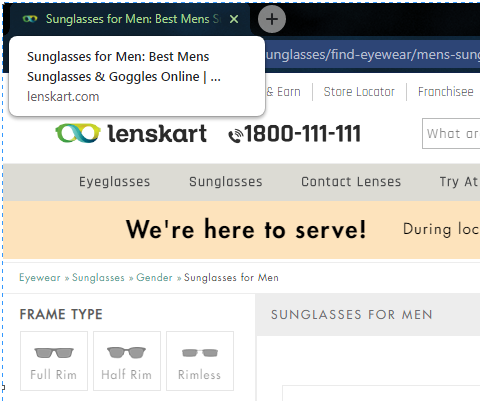
Now, check out what Coolwinks has included in its title tag on a product page.
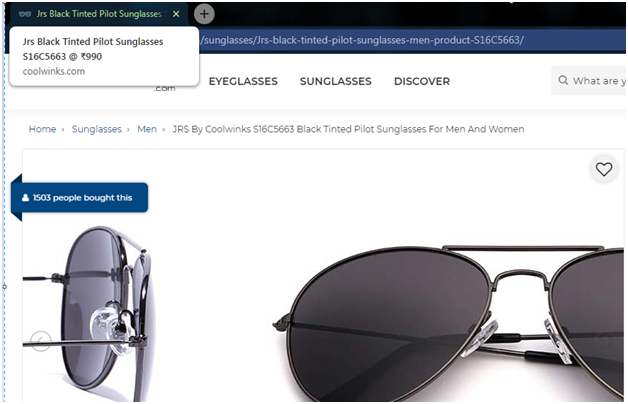
You will see ‘@’ — price, which is possibly one of the reasonable prices and ‘Black Tinted’ for more information.
All these tactics make it easier for your potential customers to reach the desired page.
So, gather the knowledge about all such modifiers that support your keyword and make it more attractive in the eyes of a buyer.
Description Tag
The modifiers we have suggested above can also be used for description tags. It’s very important to work on your description tag because they play a great role in increasing Click-Through-Rate (CTR).
The only difference between a title tag and a description tag that you can add more in the latter one.
For instance:


Phrases like “Up to 30% Off”, “Offers End Soon”, “Top Brands”, “COD” and “100% Genuine” are all golden words that grab the eyeballs of potential buyers.
Category and Product Page Content
Often considered as one of the hardest parts in the e-commerce world, this section should be laden with sufficient content that a buyer needs and wants to know about a product before making any purchase.
What to do?
a) Using detailed descriptions helps a lot. If required, one can even write descriptions with 1000+ words. The more content you provide, the better chances of ranking higher, and people get to learn why they should invest in your product when there are thousands of similar products out there.
b) Place your target keywords at least three to four times in the content. Since Google gives a bit more importance to keywords that are used at the top, it is best to keep some of them at the top of your page.
c) Use different keyword planner tools to find out more relevant and searched keywords around your topic.
d) Keep your URLs short with embedded keywords on category and product pages. Google prefers clean, short, and meaningful URLs than the ones that look junky and mind-boggling.
e) Spend some time on strategic internal linking. It is always recommended to link from high authoritative pages to high priority categories and product pages internally.
f) Get advantages of the Rich Snippets and Product Review Schema. Though there is never a guarantee that Google will display them, implementing a proper Schema markup can turn your odds.
Technical SEO for E-commerce Websites
As e-commerce web pages don’t have a lot of backlinks pointing to them, a good Technical SEO strategy becomes doubly important.
Prepare a good strategy and that starts with the Technical SEO Audit by using some of the SEO tools, such as SEMrush, Raventools, and Moz to unravel potential errors.
After performing the Technical SEO Audit, focus on significant problems as mentioned below and fix them if any.
1- Too Many Pages – often lead to duplicate or similar content. Combine category pages with slight variation. You can either delete extra pages or unindex them. Keep web pages to a minimum number for easy navigation.
2- Site Speed – your site could be slow due to bloated code, large image file sizes, slow servers, and so on. Work on these issues to boost site speed.
3- Duplicate Content – commit to unique content on every page. Use advanced SEO techniques like canonical tags. Otherwise, your site is going down as Google Panda is always there to keep a watch on such issues.
4- Thin Content – we know it’s very challenging to write long unique content for similar products but tries to write at least 500+ words for all vital product and category pages.
Keyword Research for E-commerce Websites
This step is kind of something that you should start doing from the start and keep doing regularly to ensure that your products and services are ranked for keywords that are getting trendier.
Without keywords, it is impossible to optimize your product and category pages. Besides, powerful keywords also influence your technical SEO directly or indirectly as your site architecture, URLs, and Content need keywords to take into account.
Before starting the research, you should be aware of what you need to research on. Thus, it is best if you have prior basic knowledge and learn about as many types of keywords as you can.
Common Types of Keywords in SEO
Short-tail Keyword – 3 words or less; high search volume; highly competitive
Example – shoes online; sports shoes; running shoes
Long-tail Keyword – more than 3 words; more specific; low search volume; easy to pinpoint search intent; high conversion rate
Example – best shoes for running; buy cheap shoes online
Product Defining Keyword – describe your product; less competitive; high conversion rate; the low search volume
Example – Bata Partywear Shoes; Cheap shoes with size xx
Customer Defining Keyword – imaginary profile of targeted audience; allow to focus on pain points; less competitive; high conversion rate
Example – sports shoes for kids; comfortable shoes for diabetics
Geo-targeting Keyword – critical for small local and delivery-based businesses –
Example – designer shoe stores in New Delhi
LSI Keyword – to create topics with a broad theme; boost the ranking signal for the main keyword
Example- best shoes for formal events
Intent Targeting Keywords – informational – how to or what to; commercial – product key details; transactional – best deals
Example – how to find the right shoes at best prices; what factors to consider before buying shoes
Market Segment Keyword – associated with a particular industry, brand, niche, or purpose
Example – shoes for hiking; snow boots for men
Branded Keyword – include a brand’s name; can also include product type or other descriptive phrases
Example – Adidas shoes; Puma shoes online
Competitor Keyword – target brand names of competing businesses
Example: For Adidas, Puma shoes
Broad Match Keyword – a search term with variations of the main keyword; similar phrase for ad campaigns
Example – shoes for sale
Phrase Match Keyword – a specific search phrase for queries with the exact or closely related search intent
Example – shoes for women; shoe stores for men
Exact Keyword – a specific keyword for queries with exact or closely related search intent
Example – women shoes; kids’ shoes
Negative Keyword – for intentional exclusion from ad campaigns
Example – for women’s shoes, it could be men’s shoes
Transactional Keyword – for searches where people are ready to buy
Example – buy cheap shoes online; buy the best formal shoes at discount
There are several other types of keywords that you can benefit from. So, do a deep study about them.
Now, the question arises – how to find trendy and relevant keywords for your products and services?
How to Find Keywords for E-commerce Websites
You can check out by putting the main keyword in the search box of Amazon – a great and quick way to know relevant keywords. While doing so, Amazon will show a list of suggestions for long-tail keywords that could be of use.
Just have a look at how to get keyword suggestions on Amazon.
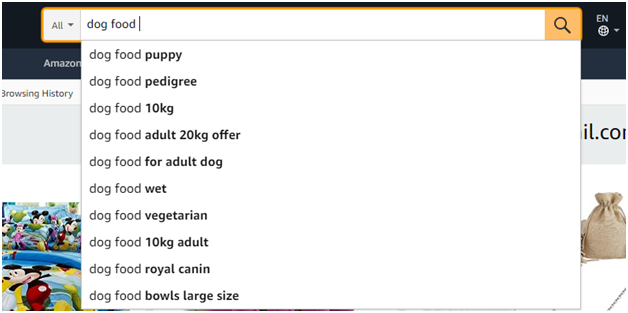
Alternatively, you can use Google’s Keyword Planner or any other reliable free keyword tool that you like. The benefit of using a keyword tool for research is that you will find additional details as well:
- More keywords
- Search volume
- Trend
- CPC
- Competition
The details you will get may vary based on the keyword tool you are using.
How to Select Keywords for Your Category and Product Pages of E-commerce Sites?
There are several factors that you should keep in mind while selecting keywords for your e-commerce category and product pages.
- Search volume – high or low search volume varies based on your business
- Competition – how much competition the keyword is already facing on the search engine
- Compatibility of keyword with your product – the keyword should describe your product exactly
- Commercial kicker – use keywords with high suggested bids as there are several tire kickers who go for high volume keywords
Content Marketing for E-commerce Websites
Now, when you know your site architecture is good, you have worked on On-Page and Technical SEO, and know which keywords are good for your e-commerce business; it’s time to strategize your content marketing plan.
The primary aim of content marketing is to get a lot of traffic and sales. So, certainly, it’s a big as well as a substantial step for you.
How to market your content?
- First of all, find out where your customers are hanging out; for instance, the most often used social media platforms, forums, or community by your target audience.
- Search what words and phrases your customers use to describe their issues, fondness, or recommendation.
- Create content (that should be unique, original, informative, and compelling) around those words and phrases.
- Link the content – blog, article, FAQs whatever suits more those keywords – to your site or product or category pages.
You can post content on your site blog page and/or try for guest posting on authoritative sites.
These points are the summary of the whole content marketing strategy that you could learn in detail through online guides.
Link Building for E-commerce Websites
The most important thing to remember is that you should focus on earning links rather than just building them in mass. A single link from an authoritative site is far more beneficial and important than useless links produced in mass quantity.
Make sure that you are delivering some value to your customers and not just a link to click and find nothing useful or irrelevant. Find out some of the authoritative blogs and sites relevant to your business or where your customers often hang out. Post content that could be valuable to your target audience. For instance:
- Guides that help them choose the right product
- Tips to avoid the products that could be the wrong choice
- Debunk misconceptions around your products and services, if applicable
- Address their pain points, issues, or problems and provide suggestions to deal with them
- Reasons why your product or service is better than others
- Inform them about deals, offers, sale, if any
Finding out what your target audience wants to know or should know is a great way to create valuable content and then, use them for link building.
Final Thoughts
This detailed guide on building an effective E-commerce SEO Strategy provides you a great insight into what you should do to rank high, interact with your audience, and boost your revenue. So, start working on the above-mentioned steps and tips right away and see the wonderful improvements to your e-commerce site and business. The competition in the e-commerce industry is getting higher and higher; so should you make your efforts more intensive to get a competitive edge.
Latest posts by Vijaya Tyagi (see all)
Top 15 Best Backlink Checker Tools for SEO 2024 - October 18, 2024
Top 10 SEO Analysis Tools: A Comprehensive Comparison Guide - October 4, 2024

